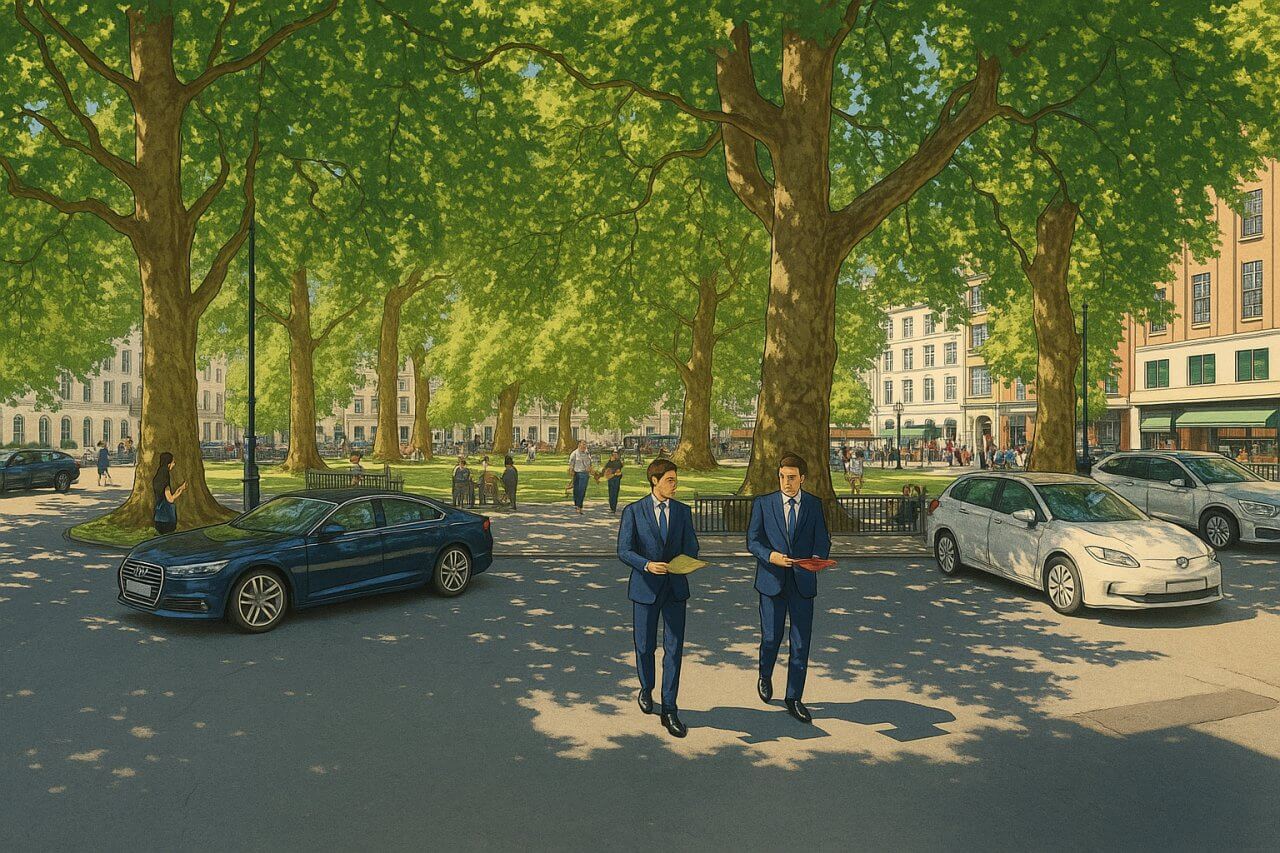
Berkeley Square, London
Berkeley Square is a distinguished garden square and the name of the roads encircling it, located in the heart of Mayfair, within the City of Westminster. Revered for its historic Georgian architecture, lush central garden, and exclusive commercial and residential properties, Berkeley Square remains one of the most desirable and refined corners of central London.
Layout and Traffic Direction
The square consists of a central green garden bordered on all four sides by a perimeter road also called Berkeley Square. This rectangular loop connects to several other important Mayfair streets, including Bruton Street to the east, Hill Street to the south, and Davies Street to the west. Although it is often referred to simply as "Berkeley Square," it functions as both a public square and a thoroughfare.
The road around Berkeley Square operates with varying traffic directions. Traffic is one-way clockwise on the eastern and northern sides and two-way on the western and southern edges. The entire road measures approximately 0.25 miles (0.4 km) in circumference.
Streets connected to Berkeley Square
- Bruton Lane
- Bruton Place
- Bruton Street
- Davies Street
- Hay Hill
- Jones Street
- Mount Street
Pronunciation and Etymology
The name Berkeley is pronounced “BARK-lee” /ˈbɑːkli/
 . The square was named after John Berkeley, 1st Baron Berkeley of Stratton, who was granted the land in the 17th century. The spelling remains "Berkeley" despite its unexpected pronunciation, a quirk shared with other British place names.
. The square was named after John Berkeley, 1st Baron Berkeley of Stratton, who was granted the land in the 17th century. The spelling remains "Berkeley" despite its unexpected pronunciation, a quirk shared with other British place names.
History and Development
Berkeley Square was laid out in the 18th century, with construction beginning in the 1730s and most buildings completed by the 1770s. The square was designed to serve as a prestigious residential address for the upper echelons of Georgian society. Notably, the garden square format—with elegant townhouses arranged around a central park—was a fashionable urban planning concept at the time.
Among its most famous former residents was Horace Walpole, writer and politician, who lived at No. 11. The square also has literary fame thanks to the English song "A Nightingale Sang in Berkeley Square", composed in 1939, which romanticized the area even as war loomed over London.
Character and Atmosphere
Berkeley Square exudes quiet prestige, combining classical elegance with modern luxury. Its leafy garden, mature London plane trees, and well-preserved Georgian façades lend it a sense of timeless charm. Today, the buildings house a blend of embassies, hedge funds, exclusive private clubs, art galleries, and high-end residential apartments. Despite its centrality, the square is relatively calm and secluded, a peaceful enclave in the bustling West End.
What to See and Do
- The Gardens: The central garden is open to the public and offers benches, walking paths, and shade from towering plane trees—some of the oldest in London, planted in 1789.
- Historic Buildings: The townhouses around the square display prime examples of Georgian architecture. Notable buildings include Lansdowne House (formerly at No. 9), part of which was moved to the Philadelphia Museum of Art.
- Public Art: The sculpture Jeté by Enzo Plazzotta, of a ballet dancer mid-leap, graces the southern side of the square.
Real Estate and Property Values
Berkeley Square is among the most expensive real estate locations in the UK. As of early 2025, office spaces in the area have been let for over £200 per square foot per year. Luxury residential flats typically start at around £4,000 per square foot (£43,000 per sq m), with some reaching £7,000 per square foot (£75,000 per sq m) for larger or historically significant properties. These values far exceed the averages across London and even across most of Westminster.
Residential units around the square vary from elegant studio apartments of around 600 sq ft (56 sq m) to entire townhouses spanning over 8,000 sq ft (743 sq m).
Nearby Transport Links
London Underground Stations
- Green Park Station (5-minute walk): Served by the Jubilee Line, Piccadilly Line, and Victoria Line.
- Bond Street Station (8-minute walk): Served by the Central Line and Jubilee Line.
- Oxford Circus Station (12-minute walk): Offers access to the Bakerloo Line, Central Line, and Victoria Line.
Bus Stops
Multiple London bus routes serve the area. The closest stops are on Berkeley Street, Curzon Street, and Piccadilly, offering routes toward St James's, the City, and other major London districts.
Fun Fact
Berkeley Square is home to what many believe is the most haunted house in London—No. 50 Berkeley Square. According to legend, the attic room is cursed, and stories of apparitions and strange deaths circulated widely in the Victorian period. Though now a commercial property, the tale continues to intrigue ghost hunters and curious tourists alike.
Quick Facts
- Location: Mayfair, City of Westminster, central London
- Length: Approx. 0.25 miles (0.4 km) in circumference
- Traffic: One-way on eastern and northern sides; two-way on southern and western sides
- Pronunciation: “BARK-lee” /ˈbɑːkli
- Named After: John Berkeley, 1st Baron Berkeley of Stratton
- Built: 1730s–1770s
- Character: Leafy, prestigious, calm yet central
- Nearby Stations: Green Park, Bond Street, Oxford Circus
- Real Estate: £4,000–£7,000 per sq ft (£43,000–£75,000 per sq m) as of 2025
- Fun Fact: Allegedly home to London's most haunted house at No. 50
Map of Berkeley Square, London

Painting of Berkeley Square, London (View image in full size)